Rethinking NPIs and Vaccinations
Tagged:COVID
/
MathInTheNews
/
PharmaAndBiotech
/
Politics
People are clamoring for an end to “restrictions”, by which they mean masks and closures. And, of course, vaccination mandates. They’re eager to be done with COVID-19, whether COVID-19 is done with them or not. Does any of that make sense? Well… some of it… maybe.
NPIs, Vaccinations, and Political Blinders
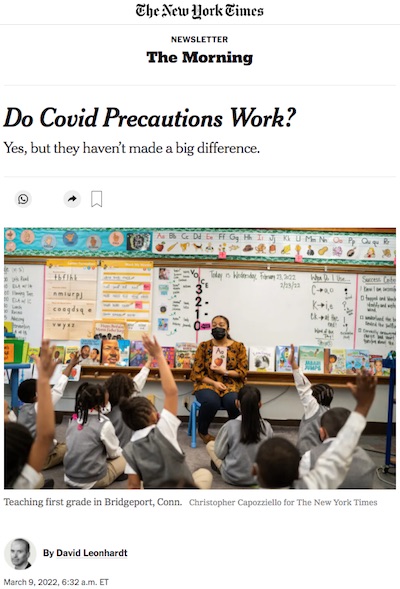
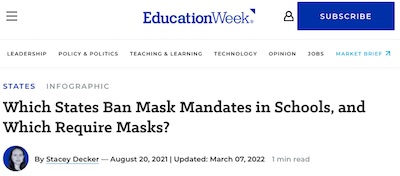 Do NPI’s (non-pharmaceutical interventions, like masks) work? From the New York Times
this morning comes an article by David Leonhardt [1] about
the American right-wing suspicion that “masks don’t work”. (They also think “vaccines
don’t work” – in spite of 90%+ efficacy, so you should conclude that American
right-wing opinions are largely evidence-free.) They’re so eager to be done with
COVID-19, that several Republican governors last year went so far as to ban mask
mandates, even going so far as to sue school districts that required masks. [2] At the time last year, that was about as smart as banning
parachutes among skydivers.
Do NPI’s (non-pharmaceutical interventions, like masks) work? From the New York Times
this morning comes an article by David Leonhardt [1] about
the American right-wing suspicion that “masks don’t work”. (They also think “vaccines
don’t work” – in spite of 90%+ efficacy, so you should conclude that American
right-wing opinions are largely evidence-free.) They’re so eager to be done with
COVID-19, that several Republican governors last year went so far as to ban mask
mandates, even going so far as to sue school districts that required masks. [2] At the time last year, that was about as smart as banning
parachutes among skydivers.
Is it any better now? Leonhardt tries to answer that question.
A Natural Experiment
It’s true that life in Red America and Blue America are very different for many reasons, but in particular different in COVID-19 attitudes. In-restaurant dining, returns to workplaces, school re-openings, and dropping masks are much higher in red areas than blue areas. We already know from deeply and completely damning evidence that red areas resist, defy, and deny vaccination (and even testing!) as well. This invites, as Leonhardt points out, what philosophers and economists call a “natural experiment”: does the fact that our natures have segregated our behavior into such different groups show up in the COVID-19 statistics?
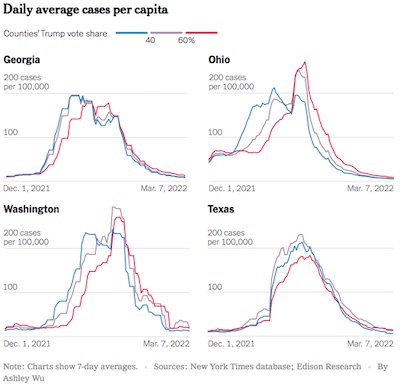
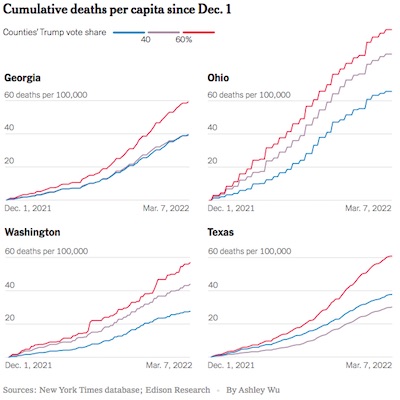 As with so many things in the real world, the answer is both “yes” and “no”, depending on
exactly how yo decide to look. The NYT data summarizes the situation with respect to
daily case rates per capita and death rates per capita:
As with so many things in the real world, the answer is both “yes” and “no”, depending on
exactly how yo decide to look. The NYT data summarizes the situation with respect to
daily case rates per capita and death rates per capita:
- These graphs are from 2021-Dec-01 to this week, so they only cover the Omicron variant, which is the most seriously contagious variant. Only measles is worse, at least to my knowledge.
- The rates are stratified by Trump vote share (low in blue, medium in gray, high in red).
- Both the horizontal and vertical scales are the same throughout, so visual comparison among the graphs is totally allowed.
- I don’t know why they chose to show only Georgia, Ohio, Washington, and Texas, other than space restrictions. More complete US data for all areas is available at the Times’s interactive COVID-19 case database, which is quite a wonderful resource.
What should we conclude from these data? Several things:
- The case rates are not materially different between the Trumpy and non-Trumpy groups, despite differences in mask use. This is not because masks don’t work, but rather because Omicron is so contagious that it will eventually overwhelm masks. Masks can slow down Omicron at best, and these data only cover the period favorable to Omicron.
- The death rates are dramatically – and drearily – different! This is almost entirely due to differences in vaccination. Vaccination will prevent many infections, and drastically lower the severity of the few that get through. Again, like parachutes: they won’t prevent you from falling out of an airplane, but they make experiencing the end result survivable. [3]
Leonhardt interviewed Christopher Murray of University of Washington, who predicted this. He said that it’s as if you had to roll a die each time you go to a public indoor venue to see if you get COVID-19. With a mask, you get COVID-19 if you roll a 1; without a mask, you get COVID-19 if you roll a 1 or a 2. So masks work: they cut the probability per unit time of infection by a factor of 2. But with Omicron the infection risk is still so high, that the virus rips through the population anyway.
Whether you live or die is driven by… vaccination, of course.
Leonhardt’s Conclusion
One, nothing matters nearly as much as vaccination. A continued push to persuade skeptics to get shots – and to make sure that people are receiving booster shots – will save lives.
Two, there is a strong argument for continuing to remove other restrictions, and returning to normal life, now that Omicron caseloads have fallen 95 percent from their peak. If those restrictions were costless, then their small benefits might still be worth it. But of course they do have costs.
Masks hamper people’s ability to communicate, verbally and otherwise. Social distancing leads to the isolation and disruption that have fed so many problems over the past two years — mental health troubles, elevated blood pressure, drug overdoses, violent crime, vehicle crashes and more.
If a new variant emerges, and hospitals are again at risk of being overwhelmed, then reinstating Covid restrictions may make sense again, despite their modest effects. But that’s not where the country is today.
(Emphasis added.)
The Weekend Conclusion
Broadly speaking, we agree here at Chez Weekend. We’re a little leery of dropping NPIs, since they do stop needless deaths. The counter-argument is that people don’t like masks (with which we agree) and that masking causes psychological damage (with which we don’t don’t really agree). Still, Leonhardt shows us data that says vaccination and boosting are important, and but masking is now less so.
Until the next variant.
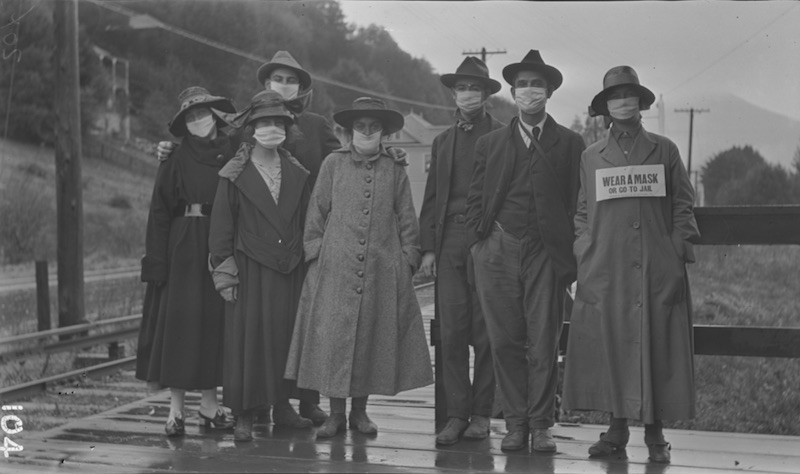
(Details on the picture above: 2021-Oct-30, in this crummy little blog that nobody reads.)
We’re a bit wary of pandemic fatigue driving us to engage in motivated reasoning to conclude that we should do what we want to do anyway. That was certainly the case in the 1918 flu pandemic in the US, as shown in a marvelous historical article by Emily Martin in National Geographic this month. [4] People really wanted the flu pandemic to be over, so just acted as if it were so – at the cost of prolonging infections for years into the 1920s, and an absolutely steadfast determination not to remember any lessons from the pandemic. Why do you think you studied World War I in school, but not the 1918 flu pandemic that killed more people? Selective blindness is why!
 So… we’ll continue to mask, but try to control our rage at seeing unmasked people,
or idiots wearing masks beneath their noses. For now. I promise I’ll personally try not
to glare at people like Bela Lugosi does here. He at least had the excuse that he was playing
Dracula in a film. [5] I’m just perpetually ticked off at
malicious/incompetent compliance about masks.
So… we’ll continue to mask, but try to control our rage at seeing unmasked people,
or idiots wearing masks beneath their noses. For now. I promise I’ll personally try not
to glare at people like Bela Lugosi does here. He at least had the excuse that he was playing
Dracula in a film. [5] I’m just perpetually ticked off at
malicious/incompetent compliance about masks.
Notes & References
1: D Leonhardt, “Do Covid Precautions Work?”, New York Times newsletter “The Morning”, 2022-Mar-09. ↩
2: S Decker, “Which States Ban Mask Mandates in Schools, and Which Require Masks?”, Education Week, original 2021-Aug-20, updated 2022-Mar-07. ↩
3: And even enjoyable, to a certain kind of personality. I’ve never been that sort of dopamine/adrenaline junkie, but I do know some of them. When I want excitement, I find the Weekend Publisher… and pet the cat. ↩
4: E Martin, “The lessons learned from 1918 flu fatigue, according to historians”, National Geographic, 2022-Mar-04. ↩
5: Yeah, this one’s for you, Ana. Though I see no family resemblance, really. ↩

Gestae Commentaria
Comments for this post are closed pending repair of the comment system, but the Email/Twitter/Mastodon icons at page-top always work.